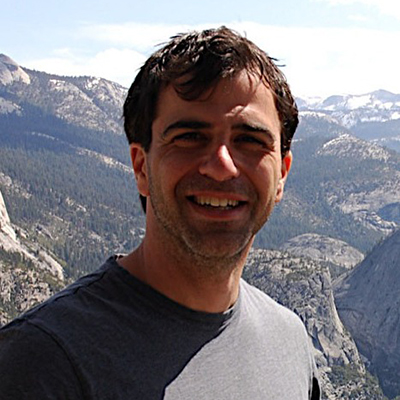
Joshua Trachtenberg, Ph.D.
UCLA Department of Neurobiology 635 Charles E. Young Drive South 503 Neuroscience Research Building Los Angeles, CA 90095-1763 (Campus Mail Code 176318)
Research Interests
The future aint what it used to be – Yogi Berra It is precisely because the future is unpredictable that the mammalian brain has evolved the capacity to acquire new information through sensory experiences, store this information as memories, and rapidly retrieve this information to modify behavior. But how do novel sensory experiences embed themselves in the fabric of the brain to form memories? This question drives the research in my laboratory, which examines the cellular and synaptic mechanisms of experience-dependent plasticity in the neocortex. Specifically, I am interested in understanding i) where experience-dependent plasticity is initiated in the cortical circuitry; ii) how experience regulates the growth or retraction of synapses; iii) whether plasticity is restricted to only a subset of synaptic connections; iv) what distinguishes “critical period” plasticity from adult plasticity; v) how synaptic plasticity is altered in the aging and diseased brain. Techniques: To address these qustions, I use: 2-photon laser scanning microscopy to repeatedly image neurons, synapses, and proteins in the living brain of mice over periods of weeks 2-photon microscopy to acutely image cellular responses to sensory stimuli using calcium imaging. Intrinsic signal optical imaging to non-invasively and repeatedly image stimulus-induced responses in populations of neurons in the intact, living brain. Microelectrodes to monitor changes in neuronal responses to visual stimuli before and after a plasticity paradigm and to determine the laminar position of these changes Using these techniques, I directly examine experience-dependent changes in structure and function in the same cortical region. Understanding how synapse formation and elimination is regulated by experience and their roles in learning and memory is critically important to developing rationally-based therapeutic approaches to diseases such as Alzheimer’s disease, and related dementias, in which cognitive impairment is strongly correlated with a loss of synapses in the cortex. Biography Joshua Trachtenberg joined the Department of Neurobiology as an Assistant Professor in July of 2003. His research focuses on understanding the cellular and circuit-wide mechanisms that underlie the acquisition and consolidation of memories in the cortex. Prior to joining the UCLA faculty, he was a postdoctoral fellow at the Cold Spring Harbor Laboratory and at the University of California, San Francisco. He received his Ph.D. in developmental neurobiology at the University of Texas at Austin and his Bachelor of Arts degree from Brandeis University.
Publications
Kuhlman Sandra J, Olivas Nicholas D, Tring Elaine, Ikrar Taruna, Xu Xiangmin, Trachtenberg Joshua T A disinhibitory microcircuit initiates critical-period plasticity in the visual cortex. Nature. 2013; 501(7468): 543-6.
Gdalyahu Amos, Tring Elaine, Polack Pierre-Olivier, Gruver Robin, Golshani Peyman, Fanselow Michael S, Silva Alcino J, Trachtenberg Joshua T Associative fear learning enhances sparse network coding in primary sensory cortex. Neuron. 2012; 75(1): 121-32.
Wyatt Ryan M, Tring Elaine, Trachtenberg Joshua T Pattern and not magnitude of neural activity determines dendritic spine stability in awake mice. Nature neuroscience. 2012; 15(7): 949-51.
Kuhlman Sandra J, Tring Elaine, Trachtenberg Joshua T Fast-spiking interneurons have an initial orientation bias that is lost with vision. Nature neuroscience. 2011; 14(9): 1121-3.
Smith Spencer L, Trachtenberg Joshua T The refinement of ipsilateral eye retinotopic maps is increased by removing the dominant contralateral eye in adult mice. PloS one. 2010; 5(3): e9925.
Matter Cheryl, Pribadi Mochtar, Liu Xin, Trachtenberg Joshua T Delta-catenin is required for the maintenance of neural structure and function in mature cortex in vivo. Neuron. 2009; 64(3): 320-7.
Faguet J, Maranhao B, Smith SL, Trachtenberg JT Ipsilateral eye cortical maps are uniquely sensitive to binocular plasticity. Journal of Neurophysiology 2009; 101(2): 855-61.
Chow DK, Groszer M, Pribadi M, Machniki M, Carmichael ST, Liu X, Trachtenberg JT Laminar and compartmental regulation of dendritic growth in vivo. Nature Neuroscience 2009; 12(2): 116-8.
Li W, Zhou Y, Jentsch JD, Brown RA, Tian X, Ehninger D, Hennah W, Peltonen L, Lonnqvist J, Huttunen MO, Kaprio J, Trachtenberg JT, Silva AJ, Cannon TD. Specific developmental disruption of disrupted-in-schizophrenia-1 function results in schizophrenia-related phenotypes in mice. Proc Natl Acad Sci U S A 2007; 104(46): 18280-5.
Smith SL & Trachtenberg JT Experience-dependent binocular competition in the visual cortex begins at eye opening. Nature Neuroscience 2007; 10(3): 370-375. Download
Holtmaat, AJ Trachtenberg, JT Wilbrecht, L Shepherd, GM Zhang, X Knott, GW Svoboda, K Transient and persistent dendritic spines in the neocortex in vivo. Neuron. . 2005; 45(2): 279-91. Download
Trachtenberg JT, Chen BE, Knott GW, Feng G, Sanes JR, Welker E, Svoboda K Long-term in vivo imaging of experience-dependent synaptic plasticity in adult cortex. Nature. . 2002; 420(6917): 788-94. Download
Trachtenberg, JT Stryker, MP Rapid anatomical plasticity of horizontal connections in the developing visual cortex. The Journal of neuroscience : the official journal of the Society for Neuroscience. . 2001; 21(10): 3476-82. Download
Trachtenberg, JT Trepel, C Stryker, MP Rapid extragranular plasticity in the absence of thalamocortical plasticity in the developing primary visual cortex. Science. . 2000; 287(5460): 2029-32. Download
Issa, NP Trachtenberg, JT Chapman, B Zahs, KR Stryker, MP The critical period for ocular dominance plasticity in the Ferret’s visual cortex. The Journal of neuroscience : the official journal of the Society for Neuroscience. . 1999; 19(16): 6965-78.
Trachtenberg, JT Fiber apoptosis in developing rat muscles is regulated by activity, neuregulin. Developmental biology. . 1998; 196(2): 193-203.
Trachtenberg, JT Thompson, WJ Nerve terminal withdrawal from rat neuromuscular junctions induced by neuregulin and Schwann cells. The Journal of neuroscience : the official journal of the Society for Neuroscience. . 1997; 17(16): 6243-55.
Son, YJ Trachtenberg, JT Thompson, WJ Schwann cells induce and guide sprouting and reinnervation of neuromuscular junctions. Trends in neurosciences. . 1996; 19(7): 280-5.
Trachtenberg, JT Thompson, WJ Schwann cell apoptosis at developing neuromuscular junctions is regulated by glial growth factor. Nature. . 1996; 379(6561): 174-7.
